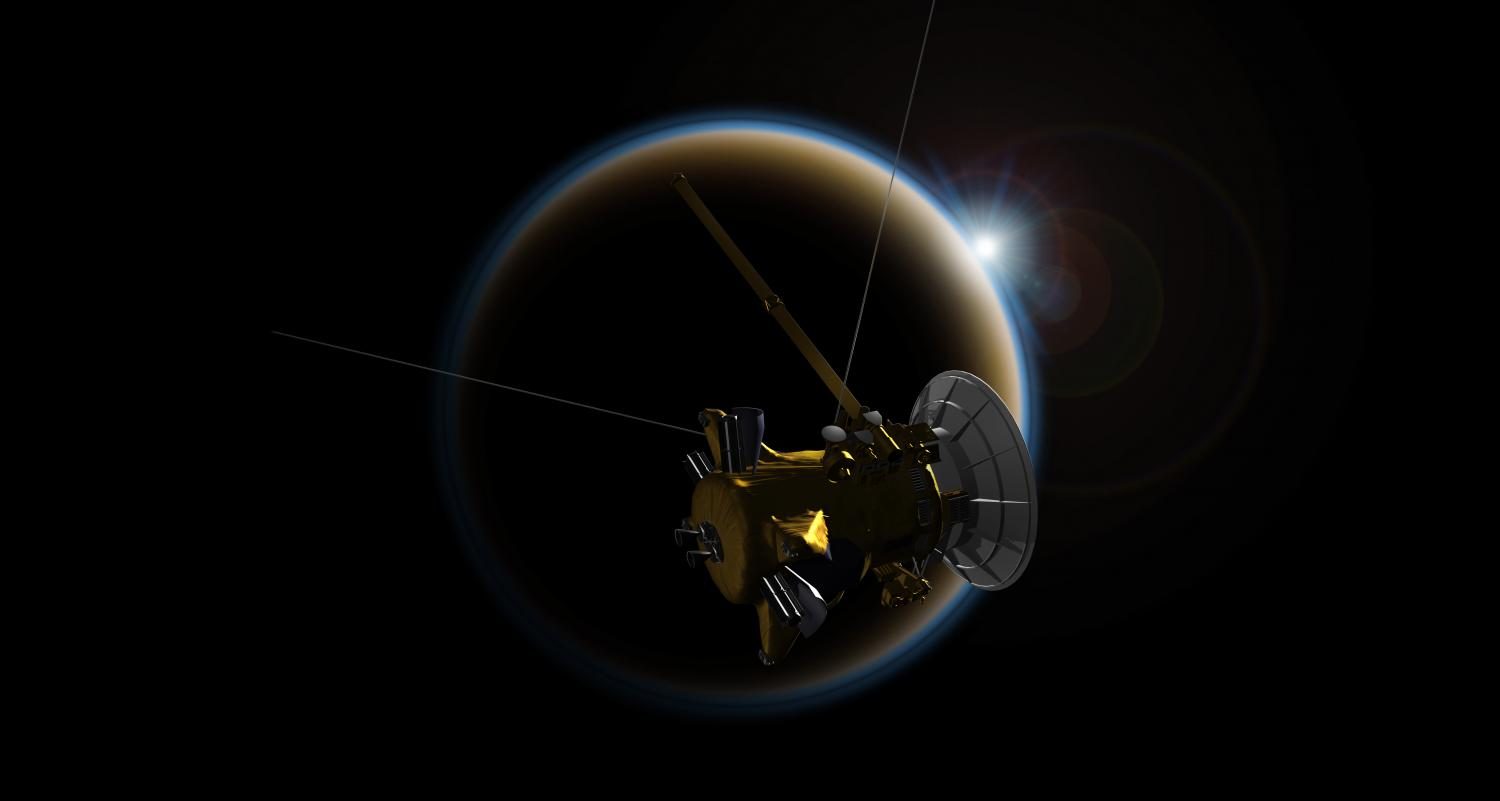Cassini spacecraft ends journey
NASA/JPL-Caltech
The Cassini spacecraft makes a flyby around Titan, one of Saturn’s moons. The spacecraft is set to plunge into Saturn’s atmosphere early tomorrow morning.
October 12, 2017
After traveling for 13 years on due course through space to Saturn and its moons, NASA’s Cassini spacecraft plunged into Saturn’s atmosphere on Friday, Sept. 15, drawing an end to its long journey.
The prime mission began in 2004, and was a collaboration between NASA, the European Space Agency (ESA), and the Italian Space Agency (ASI). The Huygens probe traveled into space with the Cassini spacecraft, but it landed on the surface of Titan in 2005, becoming the first probe to land in the outer solar system and on a moon other than our own.
The seven-year mission extension, beginning in 2010, was intended for Cassini to further explore Saturn, its rings and its moons. The initial launch took place on Oct. 15, 1997, with the spacecraft entering into orbit around Saturn on June 30, 2004.
Throughout the course of its entire mission, Cassini’s exploration was extended twice. Cassini-Huygen’s initial four-year tour of the Saturn system was completed in 2008. The following two-year extension mission, named the Cassini Equinox Mission, was a series of successful orbits around the planet and a number of flybys of the planet’s multiple moons. The second mission extension began in 2010, known as the Cassini Solstice Mission.
Over the course of last five months, the spacecraft completed a series of 22 dives between the planet and its rings, which began on April 22 and ended on Sept. 15, also known as the “Grand Finale”. Each dive lasted about six and a half days, with Cassini diving at tens of thousands of miles per hour for each one. During Cassini’s final dive before its final approach Saturn, also called the “Goodbye Kiss,” the spacecraft was able to get within 75,00 miles of Saturn’s largest moon, Titan, whose gravity slightly changed the projectile’s trajectory and made sure that.
As the fourth spacecraft to extensively travel into space solely dedicated to study and send back in-depth information on Saturn and its system of rings and moon and the first one to enter into the planet’s orbit, Cassini made several discoveries about the planet as well as its moons, including the global ocean within Enceladus, one of Saturn’s moons, as well as the liquid methane seas on Titan.
This piece was originally published in the pages of the Winged Post on October 12, 2017.


















![“[Building nerf blasters] became this outlet of creativity for me that hasn't been matched by anything else. The process [of] making a build complete to your desire is such a painstakingly difficult process, but I've had to learn from [the skills needed from] soldering to proper painting. There's so many different options for everything, if you think about it, it exists. The best part is [that] if it doesn't exist, you can build it yourself," Ishaan Parate said.](https://harkeraquila.com/wp-content/uploads/2022/08/DSC_8149-900x604.jpg)




![“When I came into high school, I was ready to be a follower. But DECA was a game changer for me. It helped me overcome my fear of public speaking, and it's played such a major role in who I've become today. To be able to successfully lead a chapter of 150 students, an officer team and be one of the upperclassmen I once really admired is something I'm [really] proud of,” Anvitha Tummala ('21) said.](https://harkeraquila.com/wp-content/uploads/2021/07/Screen-Shot-2021-07-25-at-9.50.05-AM-900x594.png)







![“I think getting up in the morning and having a sense of purpose [is exciting]. I think without a certain amount of drive, life is kind of obsolete and mundane, and I think having that every single day is what makes each day unique and kind of makes life exciting,” Neymika Jain (12) said.](https://harkeraquila.com/wp-content/uploads/2017/06/Screen-Shot-2017-06-03-at-4.54.16-PM.png)








![“My slogan is ‘slow feet, don’t eat, and I’m hungry.’ You need to run fast to get where you are–you aren't going to get those championships if you aren't fast,” Angel Cervantes (12) said. “I want to do well in school on my tests and in track and win championships for my team. I live by that, [and] I can do that anywhere: in the classroom or on the field.”](https://harkeraquila.com/wp-content/uploads/2018/06/DSC5146-900x601.jpg)
![“[Volleyball has] taught me how to fall correctly, and another thing it taught is that you don’t have to be the best at something to be good at it. If you just hit the ball in a smart way, then it still scores points and you’re good at it. You could be a background player and still make a much bigger impact on the team than you would think,” Anya Gert (’20) said.](https://harkeraquila.com/wp-content/uploads/2020/06/AnnaGert_JinTuan_HoHPhotoEdited-600x900.jpeg)

![“I'm not nearly there yet, but [my confidence has] definitely been getting better since I was pretty shy and timid coming into Harker my freshman year. I know that there's a lot of people that are really confident in what they do, and I really admire them. Everyone's so driven and that has really pushed me to kind of try to find my own place in high school and be more confident,” Alyssa Huang (’20) said.](https://harkeraquila.com/wp-content/uploads/2020/06/AlyssaHuang_EmilyChen_HoHPhoto-900x749.jpeg)







